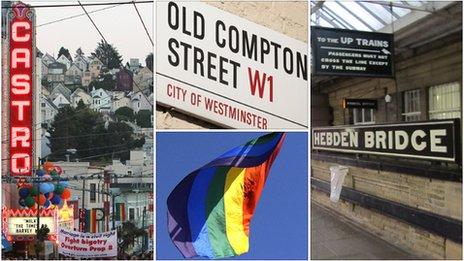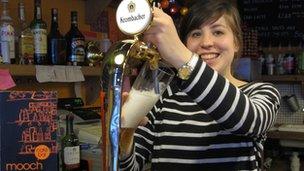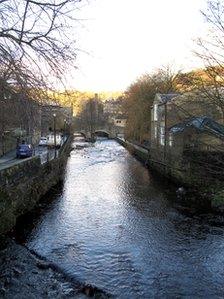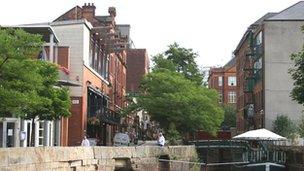Why is Hebden Bridge the lesbian capital?
- Published

Certain areas of the UK have greater concentrations of gay people and lesbians living there. But why?
Manchester. London. Brighton.
Some places in the UK are known for having a disproportionately high number of gay and lesbian people.
Such concentrations can be visible in the form of rainbow signs on bars or shops in places like Old Compton Street in London and Manchester's Canal Street.
Bigger cities are often assumed to be more tolerant places. But while one can imagine how metropolises like London, Paris and New York might disproportionately attract gay people, what about the smaller havens?
How, for instance, has a small, peaceful market town like Hebden Bridge in West Yorkshire become known as "the lesbian capital of the UK"?

Hebden Bridge is a typical market town in many ways
Sexual geography is now an academic discipline. At the moment it's LGBT (lesbian gay bisexual trans) history month and activists are teaching children why places like San Francisco are popular with gay people. There are also plans afoot to do the same for the UK.
Recent data from the Office for National Statistics has revealed that 2.5% of adults who live in London identified themselves as gay, lesbian or bisexual compared with 1.5% in the North West, 1.3% in both the South East and Yorkshire and The Humber regions.
The stats aren't usually broken down as locally as Hebden Bridge, but it has long been claimed that it has more lesbian people per head than anywhere else in the UK.
The approach to Hebden Bridge by train is what you'd expect of any other Yorkshire town at this time of year. Stunning hills punctuated by leafless trees glistening in the winter sun. Yorkstone houses with smoke billowing out of their chimneys. Old bridges crossing trickling streams.
But there are signs that something is slightly different - the lesbian dining company business card in the foyer of a bar, the same-sex greetings cards in the shop window.
For anybody who misses these hints, there are more obvious clues in the names of some of the businesses, such as the homeware shop, Home…Oh!
There is a slew of gay and lesbian businesses - from dog walkers, decorators and fashion to wine bars and hotels.
Hebden Bridge first became known for alternative lifestyles in the 1970s, says native Paul Barker, author of the forthcoming book Hebden Bridge: A Sense of Belonging.
"It was a small mill town in steep decline," he says. "There were lots of squatters who had creative skills - writing, painting or music - so it started as an arts-based thing. Being a tolerant place allowed this scene to develop while people came to visit friends and realised the freedom to be able to live how they wanted to."
Hebden Bridge's tolerance seems to go hand-in-hand with being considerably more bohemian than a typical market town.

Amy feels less self-conscious holding her girlfriend's hand in Hebden Bridge than other places
The town centre is a medley of organic, locally sourced and vegetarian eateries, independent coffee houses, eco-friendly clothing and knick-knack shops, arts and culture venues and a handful of high street names. Some people might even dub it a sort of Yorkshire San Francisco.
It's easy to imagine its modern atmosphere being at least in part a result of colonisation by former hippies in the 1970s.
"It's nice to just be, without feeling you're in a minority or an exception," says Amy Mellis, 29, a lesbian entrepreneur working part-time in a bar while getting a textile business off the ground. "If you go anywhere else, you feel self-conscious holding hands with your partner but not here."
Gay people often choose to live in places they identify as having increased freedom, says Sally Hines, director of the centre for interdisciplinary gender studies at the University of Leeds.

Property prices in Hebden Bridge were cheap during the 1970s
"Often these cities will have a history of progressive local government policy towards supporting and financing LGBT-friendly initiatives."
But not everybody can choose where they live, says Hines. Many working class young people do not move to go to university and are limited in where they can find work, she suggests. Older people are also not always able to move to a new region.
There's a stereotype that big cities are more tolerant while rural areas can be more closed-minded. It's not necessarily true, as the existence of Hebden Bridge - a small town with a significantly tolerant community - might suggest.
"Cities are not 'safe havens' - even ones with vibrant 'gay villages' - and rural areas are not intrinsically homophobic," Hines argues.
There is also a circular pattern of migration. Once an area has established a reputation as somewhere gay people live, more gay people are drawn there.
People want to blend in somewhere, and even feel anonymous.
"For many years, being gay meant running away from family to a place where you could be anonymous. You ran for anonymity. Brighton has for many years had a reputation as a place to run to because it is an open-minded place where you can be who you want to be," says gay writer and Brighton resident Simon Fanshawe.
"What you also find about Brighton and other sea towns is that you can find work fairly easily. You didn't necessarily need specific skills to work here. As more people find out about a place like this, more people come."

Manchester has a reputation as a gay-friendly city thanks to areas like Canal Street
Thus the big cities like London and Manchester and the seaside towns like Brighton, Blackpool and Bournemouth have earned reputations as gay-friendly places. But the reasons can be as much economic as anything else.
"The gay districts of Manchester, for example, are heavily linked to cheap brewery loans and old industrial architecture," says Fanshawe. Hebden Bridge's boom was fuelled by cheap house prices in the 1970s and 1980s.
But ask anybody in Hebden Bridge about the appeal of the town to gay and lesbian people and they usually wax lyrical about "community spirit".
Walking around the town's picturesque streets, you notice the regularity of people greeting each other.
"A lot of women here have children," says Mellis. "It's an appealing place to bring up children. Women feel safe and included. My girlfriend and I have talked about settling down here and having kids."